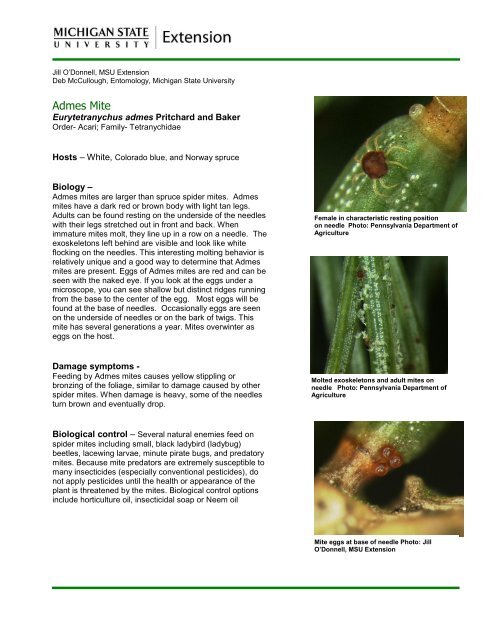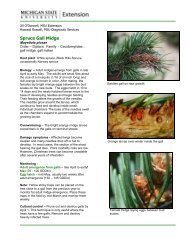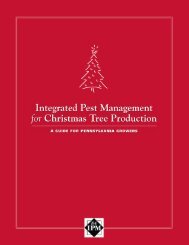Spruce Gall Midge - Michigan State University
Spruce Gall Midge - Michigan State University
Spruce Gall Midge - Michigan State University
You also want an ePaper? Increase the reach of your titles
YUMPU automatically turns print PDFs into web optimized ePapers that Google loves.
Jill O’Donnell, MSU Extension<br />
Deb McCullough, Entomology, <strong>Michigan</strong> <strong>State</strong> <strong>University</strong><br />
Admes Mite<br />
Eurytetranychus admes Pritchard and Baker<br />
Order- Acari; Family- Tetranychidae<br />
Hosts – White, Colorado blue, and Norway spruce<br />
Biology –<br />
Admes mites are larger than spruce spider mites. Admes<br />
mites have a dark red or brown body with light tan legs.<br />
Adults can be found resting on the underside of the needles<br />
with their legs stretched out in front and back. When<br />
immature mites molt, they line up in a row on a needle. The<br />
exoskeletons left behind are visible and look like white<br />
flocking on the needles. This interesting molting behavior is<br />
relatively unique and a good way to determine that Admes<br />
mites are present. Eggs of Admes mites are red and can be<br />
seen with the naked eye. If you look at the eggs under a<br />
microscope, you can see shallow but distinct ridges running<br />
from the base to the center of the egg. Most eggs will be<br />
found at the base of needles. Occasionally eggs are seen<br />
on the underside of needles or on the bark of twigs. This<br />
mite has several generations a year. Mites overwinter as<br />
eggs on the host.<br />
Female in characteristic resting position<br />
on needle Photo: Pennsylvania Department of<br />
Agriculture<br />
Damage symptoms -<br />
Feeding by Admes mites causes yellow stippling or<br />
bronzing of the foliage, similar to damage caused by other<br />
spider mites. When damage is heavy, some of the needles<br />
turn brown and eventually drop.<br />
Molted exoskeletons and adult mites on<br />
needle Photo: Pennsylvania Department of<br />
Agriculture<br />
Biological control – Several natural enemies feed on<br />
spider mites including small, black ladybird (ladybug)<br />
beetles, lacewing larvae, minute pirate bugs, and predatory<br />
mites. Because mite predators are extremely susceptible to<br />
many insecticides (especially conventional pesticides), do<br />
not apply pesticides until the health or appearance of the<br />
plant is threatened by the mites. Biological control options<br />
include horticulture oil, insecticidal soap or Neem oil<br />
Mite eggs at base of needle Photo: Jill<br />
O’Donnell, MSU Extension
Admes Mite<br />
(Eurytetranychus admes Pritchard and Baker)<br />
Chemical control - If insecticides must be used, spray<br />
only the trees that are severely infested. This will help<br />
conserve the beneficial natural enemies of the mites.<br />
Products include: abamectin, bifenthrin*, chlorpyrifos*,<br />
clofentezine, hexythiazox, oxydemeton-methyl*, propargite*,<br />
spirodiclofen. * restricted use<br />
Note: Predatory mites are important biological control<br />
agents for plant-feeding mites like spruce spider mites and<br />
Admes mites. It is important to conserve and protect the<br />
populations of native predatory mites that will be present in<br />
your Christmas tree plantation. Broad spectrum insecticides<br />
may control plant-feeding mites but are very harmful to<br />
populations of predatory mites. If a pesticide is needed to<br />
control damaging species of mites, it is preferable to choose<br />
a mitecide that won’t harm predatory mites and predatory<br />
insects.<br />
Predatory mites<br />
Courtesy- Dave Cappaert<br />
Source; Eurytetranychus admes Pritchard and Baker, Rayanne Lehman, Pennsylvania Department of Agriculture<br />
April 2011<br />
MSU is an affirmative-action, equal-opportunity employer. <strong>Michigan</strong> <strong>State</strong> <strong>University</strong> Extension programs and materials are<br />
open to all without regard to race, color, national origin, gender, gender identity, religion, age, height, weight, disability,<br />
political beliefs, sexual orientation, marital status, family status or veteran status. Issued in furtherance of MSU Extension<br />
work, acts of May 8 and June 30, 1914, in cooperation with the U.S. Department of Agriculture. Thomas G. Coon, Director,<br />
MSU Extension, East Lansing, MI 48824. This information is for educational purposes only. Reference to commercial<br />
products or trade names does not imply endorsement by MSU Extension or bias against those not mentioned.





